Sizing Up Servers: Intel's Skylake-SP Xeon versus AMD's EPYC 7000 - The Server CPU Battle of the Decade?
by Johan De Gelas & Ian Cutress on July 11, 2017 12:15 PM EST- Posted in
- CPUs
- AMD
- Intel
- Xeon
- Enterprise
- Skylake
- Zen
- Naples
- Skylake-SP
- EPYC
Intel’s Turbo Modes
A last minute detail from Intel yesterday was information on the Turbo modes. As expected, not all of the processors actually run at their rated/base frequency: most will apply a series of turbo modes depending on how many cores are registered as ‘active’. Each core can have its frequency adjusted independently, allowing VMs to take advantage of different workload types and not be hamstrung by occupants on other VMs in the same socket. This becomes important when AVX, AVX2 and AVX-512 are being used at the same time.
Most of the turbo modes are a sliding scale, with the peak turbo used when only one or two cores are active, sliding down to a minimum frequency that may be the ‘base’ frequency or just above it. There’s a lot of information for the parts here, so we’ll break it down into stages.
First up, a look at the Platinum 8180 in the different modes:
It should be worth noting what the base frequency actually is, and some of the nuance in Intel’s wording here. The base frequency is the guaranteed frequency of the chip – Intel sells the chip with the base frequencies as the guarantee, such that when the chip is not idle and not in normal conditions (i.e. when not in thermal power states to reduce temperature) should operate at this frequency or above it. Intel also lists the per-core turbo frequencies as ‘Maximum Core Frequencies’ indicating that the processors could be running lower than listed, depending on power distribution and requirements in other areas of the chip (such as the uncore, or memory controller). It’s a vague set of terms but ultimately the frequency is determined on the fly and can be affected by many factors, but Intel guarantees a certain amount and provides guides as to what it expects the turbo frequencies to be.
As for the Platinum 8180, it keeps its top turbo modes while up to two cores are active, and then drops down. It does this again for another two cores, and a further two cores. From this point, under non-AVX load the CPU is pretty much the same frequency until >20 cores are loaded, but does not decrease that much in all. For AVX 2.0 and AVX-512, the downward slope of more cores means less frequency continues, with AVX-512 taking a bigger jump down at 13 cores loaded. The final turbo frequency for AVX-512 running on all cores is 2.3 GHz.
Comparing the two 28-core CPUs for which we have turbo information gives this graph. The numbers relate to the number of cores need to be loaded for that frequency.
Both processors are equal to each other for dual core loading, but the separation occurs when more cores are loaded. As we move through to AVX 2.0 and AVX-512, it is clear where the separations are in performance – to get the best for variable core loading, the more expensive processors are required.
Here’s the big table for all the processors on Non-AVX loading:
Despite the 2.0/2.1 GHz base on most of the Platinum series, all the CPUs will turbo up to 3.7-3.8 GHz on low core loading except for the lower power Platinum 8153. For users wanting to strike a good balance between the core count and frequency, the Gold 6154 is probably the place to be: 18 cores that will only ever run at 3.7 GHz with non-AVX loading (3.5-2.7 GHz on AVX-512 depending on core count), and will be $3543 as a list price at 205W. It is perhaps worth noting that this will likely top any of the Core i9 processors planned: at 18-cores and 205W for 3.7 GHz, the Core i9-7980XE which will have 18 cores but run 165W will likely be clocked lower (but also only ~$2000).
Moving onto AVX2.0 and AVX-512:


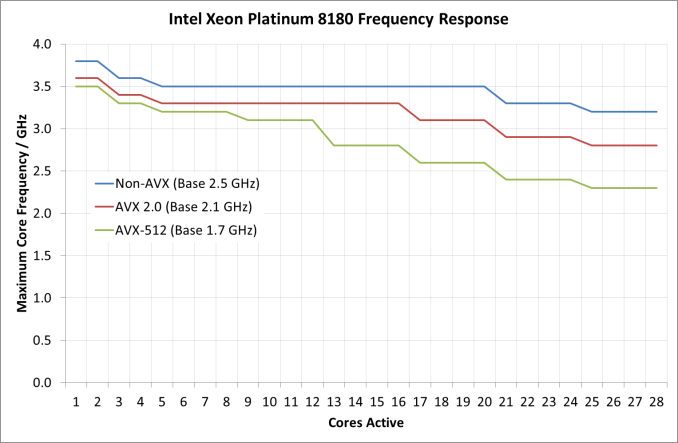
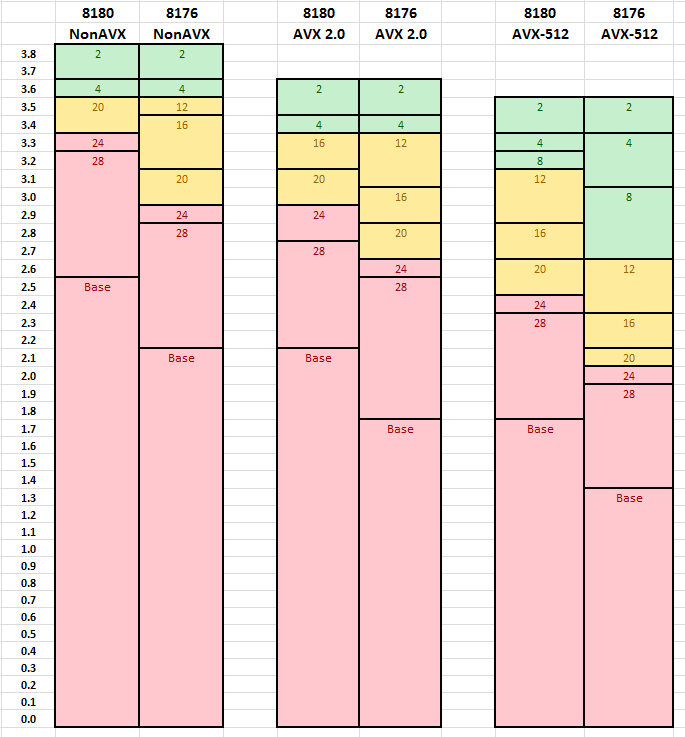
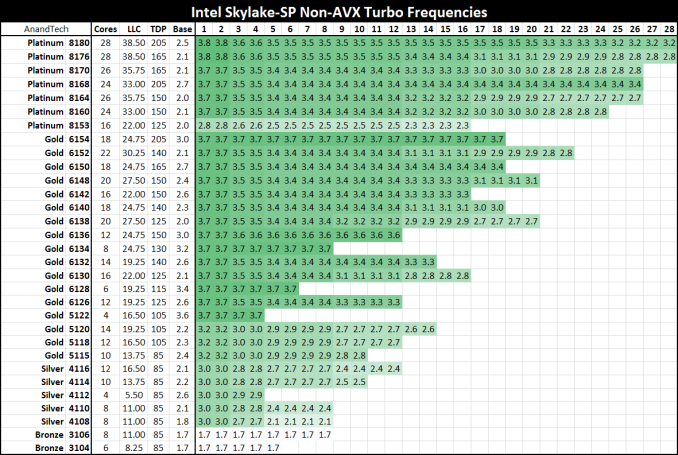
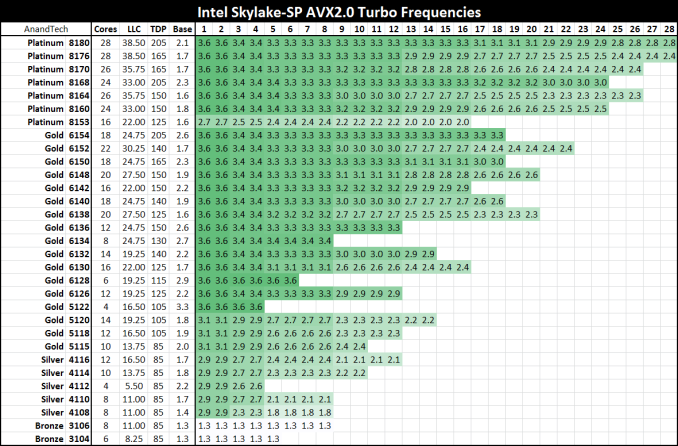
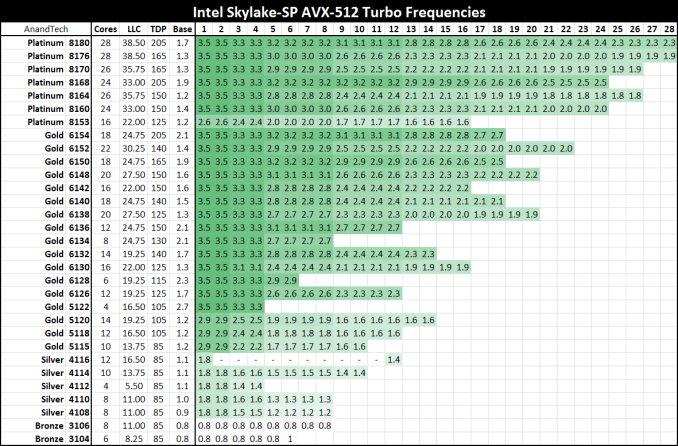








219 Comments
View All Comments
extide - Tuesday, July 11, 2017 - link
PCPer made this same mistake -- Nehalem/Westmere used a crossbar memory bus -- not a ringbus. Only Nehalem/Westmere EX used the ringbus (the 6500/7500 series) The i7 and Xeon 5500 and 5600 series used the crossbar.extide - Tuesday, July 11, 2017 - link
Sandy Bridge brought the ringbus down to Xeon EP and client chips.Yorgos - Tuesday, July 11, 2017 - link
"With the complexity of both server hardware and especially server software, that is very little time. There is still a lot to test and tune, but the general picture is clear."No wonder why we see ubuntu and ancient versions of gcc and the rest of the s/w stack.
Imagine if you tried to use debian or rhel, it would take you decades to get the review.
eligrey - Tuesday, July 11, 2017 - link
Why did you omit the Turbo frequencies for the Xeon Gold 6146 and 6144?Intel ARK says that the 6146's turbo frequency is 4.2GHz and the 6144's is 4.5GHz.
eligrey - Tuesday, July 11, 2017 - link
Oops, I mean 4.2GHz for both.boozed - Tuesday, July 11, 2017 - link
Need more Skylake-SP SKUsrHardware - Tuesday, July 11, 2017 - link
For the purley system, It's listed that you used Chipset Intel Wellsburg B0This information cannot be correct. Lewisburg Chipset is the name of the purley chipset. Also, B0 stepping lewisburg also wouldn't boot with the stepping of CPU you have.
rHardware - Tuesday, July 11, 2017 - link
That 0200011 microcode is also very old.Rickyxds - Tuesday, July 11, 2017 - link
I'am a brazilian processors enthusiast and I'am very critic about intel and AMD processors, between 2012 and Q1 2017 AMD just doesn't existed, who bought AMD on that years, bougth just for love AMD and just it, doesn't for the price, doesn't for the high core count, doesn't for AMD is red, AMD was the worst performance processors. The A9 Apple dual core performance is better than FX 8150.But now I am very surprise with the aggressive AMD prices. No one here Imagined get the Ryzen 7 performance for less than $500. And I don't know if this scenario brings profit to AMD, but for the image against the intel it's wonderful.
On the next years we will see.
krumme - Tuesday, July 11, 2017 - link
Thank you for quality stuff article especially given the short time. So thank you for booting up Johan !Interesting and surpricing results.